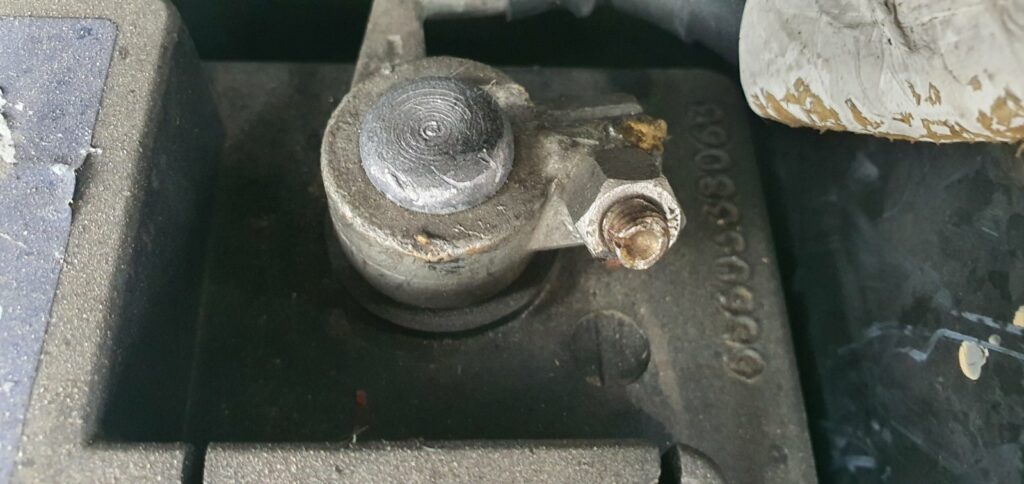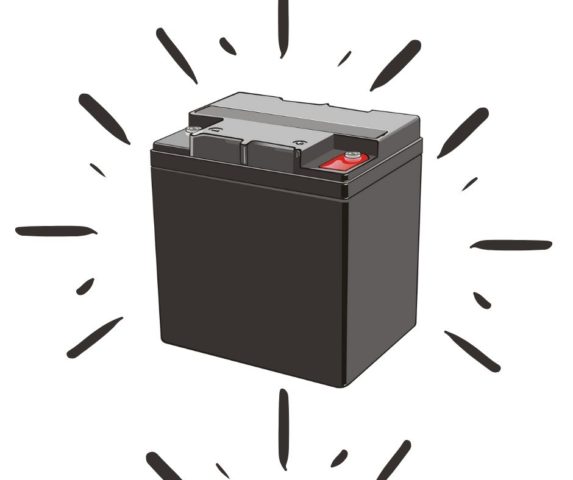Car batteries are devices that transform chemical energy into electricity. This means that the battery is filled with acid.
A leaking battery is something that doesn’t happen very often. But, when it does, one can ask himself ”Is it safe to drive with a leaking battery?”
Key Takeaway
- It is not safe to drive with a leaking battery because the sulfuric acid that is found in car batteries is dangerous for the car, the user, and the environment.
- The battery acid will cause corrosion through oxidation on the engine components. It will not dissolve plastic because the battery case itself is made of plastic.
- If it starts leaking underneath the car, sulfuric acid can dissolve limestone, cement, and concrete. If you get in contact with sulfuric acid, you might end up with skin burns, irritated throat, and difficulty breathing.
Purpose Of Car Battery

The purpose of a car battery is to provide the electrical power needed to start the engine and power all the electrical components in the vehicle. It does this by storing chemical energy and converting it into electrical energy.
The battery powers the starter motor, which in turn starts the chemically-powered internal combustion engine. In addition, the battery supplies additional current when the charging system cannot meet the vehicle’s electrical demand and stabilizes the voltage to keep your engine running.
Is It Safe To Drive With a Leaking Battery

No, it is not safe to drive with a leaking battery because it contains sulfuric acid, which is dangerous and can cause a fire, explode, melt metal components under the hood, or even result in severe skin irritation.
Furthermore, a leaking battery can potentially damage your car’s electrical system or even cause an explosion due to the release of highly explosive hydrogen gas.
The sulfuric acid can burn through limestone, concrete, and cement. This means that if your car battery is leaking into your driveway, it will damage your concrete, cement, or limestone.
The sulfuric acid smells like rotten eggs. If you somehow don’t notice the leak and touch the acid, you might end up with a skin burn, difficulty breathing, and an irritated throat. If you touch your eyes, you might end up blind.
As far as the vehicle components, the sulfuric acid will corrode any metal components found under the hood. The sulfuric acid will not burn any plastic because the battery case itself is made out of plastic.
Therefore, if you notice that your battery is leaking, it’s recommended to get it inspected and replaced immediately by a professional.
Signs Of Leaking Car Battery
- A smell of sulfur or rotten eggs
- Bubbling liquid seeping from the vent cap
- A warped, bloated, or distorted battery casing
- Visible crack leaking acid
- Powdery substance around the terminals or battery compartment
- Decreased car performance or difficulty starting the vehicle
- Corrosion or rust on the battery terminals
- The battery frequently needs jump-starting
- Electrical issues like flickering lights or malfunctioning accessories
What Causes a Battery Leak
- Damage to the battery case
- Over-charging the battery
- Engine vibrations
- Corroded or damaged battery terminals
Like I said before, a battery leak is something that doesn’t happen very often. But, it does happen sometimes. There are some things that can cause a battery to leak acid:
1. Damage to the battery case

The battery case is made of plastic. The case itself can get damaged during transportation or handling. The damage to the case could be very small, but over time it will get bigger from the engine vibrations. If the battery case is cracked, the sulfuric acid can leak out and your battery won’t work anymore.
2. Over-charging a battery

If your battery is dead and you want to recharge it, there are a couple of things that you need to know.
The most important thing that you need to do is to charge your battery in an open space.
When the battery charges, due to the chemical reaction happening inside, fumes are emitted and those fumes are dangerous for you. That’s why it’s important to charge the battery so that those fumes can easily vent out.
The next important thing is to follow the manufacturer’s recommendation on battery charging time.
You don’t want to overcharge your battery. If you overcharge your battery, hydrogen sulfide is produced and the top plastic part of the battery looks like it’s about to blow up. If your battery looks like that after charging, make sure to never use it.
3. Engine vibrations

If your car battery has even small damage on the case, even a crack so small that it’s hard to see with your bare eyes, over time it will get damaged from engine vibrations.
As we all know engines vibrate when they operate. Those small but constant vibrations will cause the crack to spread out over time. Also, driving over potholes is not helping the case.
Eventually, when your case is cracked enough, the acid will leak out, and not only will you have a damaged battery, but also damaged engine parts.
4. Corroded or damaged battery terminals

Sometimes the battery terminals, both negative and positive tend to corrode. Corroded terminals reduce electricity production by 30%. If you notice that your terminals are starting to corrode, disconnect the battery and clean the terminals with a wire brush.
Once you clean the terminals, spray them with anti-corrosion spray to prevent future corrosion. This is important because severely corroded terminals have a weaker structure and can crack from engine vibrations. If your terminals crack, the acid will escape from there.
How Bad Is a Leaking Car Battery?
A leaking car battery is quite dangerous. The battery contains sulfuric acid, which is corrosive and toxic. If it leaks, it can cause damage to your vehicle’s metal components and electrical system.
It can also pose health risks, as contact with the skin can lead to irritation, and inhaling the fumes can cause respiratory issues.
Moreover, a leaking battery can potentially result in a fire or explosion due to the release of hydrogen gas.
Therefore, it’s important to handle a leaking battery with extreme care and seek professional help immediately for its replacement.
Can a Battery Leak And Still Work?
Yes, a battery can leak and still work, but it’s not safe or advisable to continue using it. A leaking battery indicates that the battery is damaged or defective, and it could fail at any time.
The leakage is typically corrosive acid, which can damage the vehicle’s components, including the electrical system.
Moreover, a leaking battery poses serious safety risks such as potential fires or explosions due to the release of hydrogen gas.
Can You Jump Start a Leaking Battery?
No, you should never try to jump-start a leaking battery. The battery contains sulfuric acid which, when leaked, can be extremely hazardous.
Trying to jump-start a leaking battery can lead to sparks which may ignite the leaking acid or any hydrogen gas being released, potentially causing an explosion.
Also, the corrosive acid can damage your vehicle’s electrical system and metal parts.
How To Clean Up After Battery Leak
The acid inside of a battery is harmful to people, cars, and the environment. The battery acid or sulfuric acid is very corrosive. It can burn your skin, contaminate your land and corrode anything that it has leaked on. It is important that you clean up after a battery leak.
Here is how:
1. Put on protective gear
Before you start, you have to put your protective gear on. You will need eye goggles and rubber gloves. Also, make sure that your hands are not exposed, so wear a long shirt. The battery acid is dangerous to the skin and eyes so you have to be careful.
2. Inspect the leaked area before removing the battery
You need to inspect the area where the battery has leaked. If you have an acid leak on top of the battery where the terminals are, you must put baking soda on top of the battery to neutralize the acid. You will notice bubbling. Add baking soda as long as you see bubbles.
3. Remove the car battery
If you don’t have an acid leak on top of the battery, you can go ahead and remove the battery and place it in a plastic bag or a plastic container. I go with plastic because the battery acid can’t damage the plastic. Make sure that you secure the terminal clamps so they don’t touch the contaminated area.
4. Put baking soda to neutralize the acid
Now you will have to put baking soda in all places where the battery acid leaked to neutralize it. You will notice bubbling. Keep putting baking soda as long as you see bubbles. Once the bubbles stop, you are ready for the next step.
5. Wipe out the contaminated area
For this step, you can use a paper towel. You need to carefully wipe out all the acid and place the paper towels in a plastic bag or plastic container. You can put the paper towel in the same bag or container with the leaked battery.
6. Take your battery to a recycling center
Once the battery is secured into the plastic bag or plastic container, go to the local recycling center and dispose of the battery. If your battery is leaking, it is no longer useful to you. It has to be disposed of safely because it is dangerous.
In Conclusion
Driving with a leaking battery is not safe under any circumstances. The sulfuric acid contained within the battery poses serious risks, including the potential to cause fires, explosions, and significant damage to your vehicle’s metal components or electrical system.
In addition, exposure to this acid can lead to severe skin irritation. If you suspect your car battery is leaking, it’s crucial to have it inspected and replaced by a professional immediately to avoid these dangerous situations.
